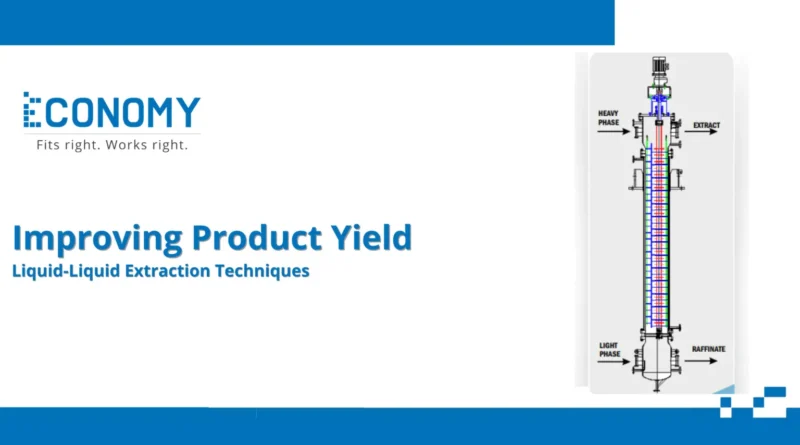Improving Product Yield: Liquid-Liquid Extraction Techniques
Importance Of Product Yield In Industrial Processes
In industrial processes, product yield plays a pivotal role in determining the economic viability and overall efficiency of production. High product yield translates directly to better resource utilization, reduced waste, and enhanced profitability. The importance of optimizing product yield can hardly be overstated, as it serves as a key performance indicator that reflects not only the efficiency of the process but also its financial soundness.
When product yield is maximized, it implies that the raw materials are being used in the most effective manner, reducing the need for excess input and minimizing the production costs. This is particularly crucial in industries dealing with costly or scarce raw materials, where any loss in yield could have significant financial repercussions.
Furthermore, improving product yield can have a substantial environmental impact. In the context of sustainability, higher yields mean that less raw material extraction is required for the same amount of product, thereby conserving natural resources and lowering the environmental footprint of the manufacturing process. Efficient processes result in less waste generation, reducing the burden on waste treatment and disposal systems, and fostering a more sustainable production model.
Moreover, many industries are governed by stringent environmental regulations which mandate the reduction of waste and emissions. By maximizing yield, companies can more easily comply with these regulations, avoiding potential fines and enhancing their reputation as responsible corporate citizens.
Liquid-Liquid Extraction (Lle) Fundamentals
Liquid-liquid extraction (LLE) is a separation process that relies on the different solubilities of compounds in two immiscible liquid phases. Typically, one of these liquids is an aqueous phase and the other is an organic solvent. This technique is particularly useful for separating compounds that have similar boiling points or when thermal degradation is a concern, thus making distillation ineffective or impractical.
The fundamentals of LLE start with the concept of distribution coefficient (K), which is defined as the ratio of the concentration of a solute in the organic phase to its concentration in the aqueous phase. This coefficient is crucial in determining the efficiency of the extraction process. A higher distribution coefficient means that more solute is transferred to the extracting solvent, thus making the process more effective.
The process can be categorized into single-stage and multi-stage extractions. In single-stage extraction, the two immiscible liquids are brought into contact in a suitable vessel, allowing the solute to transfer from the feed solution to the solvent. After the desired equilibrium is reached, the two liquid phases are separated. However, single-stage extraction is often insufficient for achieving high purity or removal efficiency.
Thus, multi-stage extraction employs multiple contacting stages to enhance the extent of solute recovery. The solute is progressively transferred through several stages, increasing the overall efficiency of the process. Another key concept in LLE is the importance of phase equilibrium data. This data indicates how the solute distributes itself between the two phases, and is usually represented in the form of a ternary phase diagram.
Techniques For Improving Product Yield In Liquid-Liquid Extraction
In Industries Benefiting from LLE Techniques requires a multidimensional approach that considers various factors including solvent selection, process optimization, and equipment efficiency. One of the most critical elements in enhancing yield is choosing the right solvent. The solvent must have high selectivity for the target compound while being immiscible with the feed solution. This selects for a solvent that can dissolve the target more effectively than the feed liquid, optimizing the partition coefficient.
Another technique is to implement multi-stage extraction systems. In a single-stage extraction, the contact between the solvent and feed is limited, often resulting in suboptimal separation. By employing multi-stage extraction, either in a batch or continuous mode, each stage progressively extracts more of the target compound from the feed solution, significantly improving the overall yield.
Temperature also plays a pivotal role in liquid-liquid extraction. By altering the temperature, one can manipulate the solubility of compounds in the respective phases. Higher or lower temperatures can enhance the solubility of the desired product in the solvent phase, depending on the chemical nature of the substances involved. Adjusting the pH can also improve extraction efficiency for certain acids, bases, or ionic compounds.
Energy Efficiency In Liquid-Liquid Extraction
When considering the overall efficiency of liquid-liquid extraction (LLE) processes, energy efficiency stands as a pivotal aspect that directly influences both operational costs and environmental impact. The extraction process itself requires a series of steps that often include mixing, settling, and sometimes temperature regulation, all of which can be energy-intensive. Optimizing each of these steps is essential to ensure the process is economically sustainable.
One of the crucial ways to enhance energy efficiency is by optimizing the mixing stage. Efficient mixing can be achieved through the use of advanced mixers that utilize minimal energy while ensuring thorough contact between the two immiscible liquids. Proper mixing not only improves the separation efficiency but also reduces the time required for the separation process, indirectly saving energy. Another critical area is temperature control.
Liquid-liquid extraction often relies on precise temperature settings to achieve optimal separation. Utilizing heat exchangers and energy recovery systems can significantly cut down the energy required for heating and cooling stages. For instance, integrating a counter-current heat exchange system can recover heat from the outgoing stream to preheat the incoming stream, thereby reducing the overall energy consumption. Automation and process control technologies also offer a promising avenue for enhancing energy efficiency in liquid-liquid extraction.




